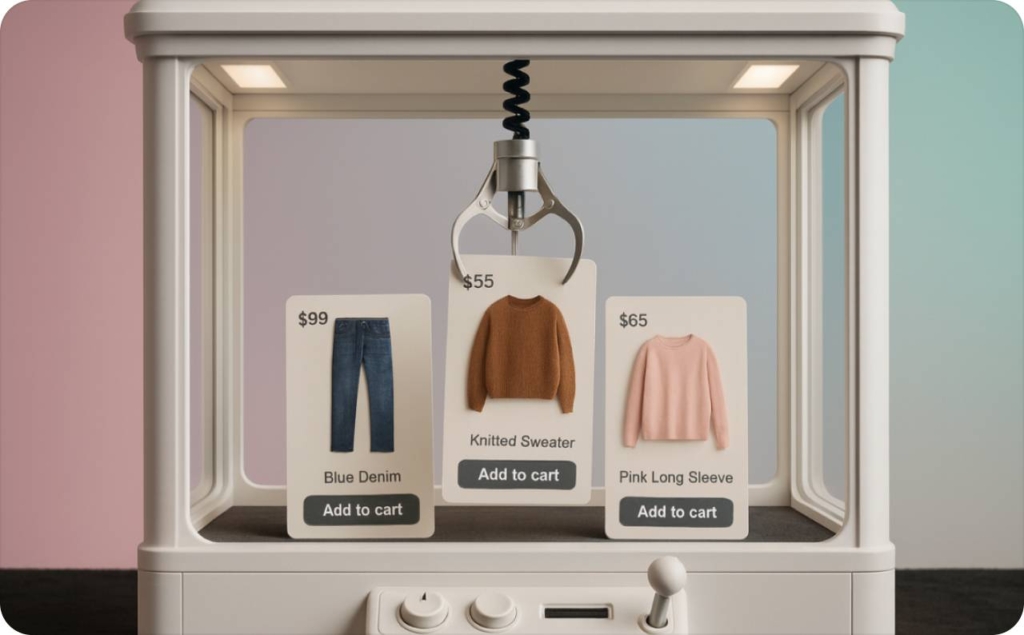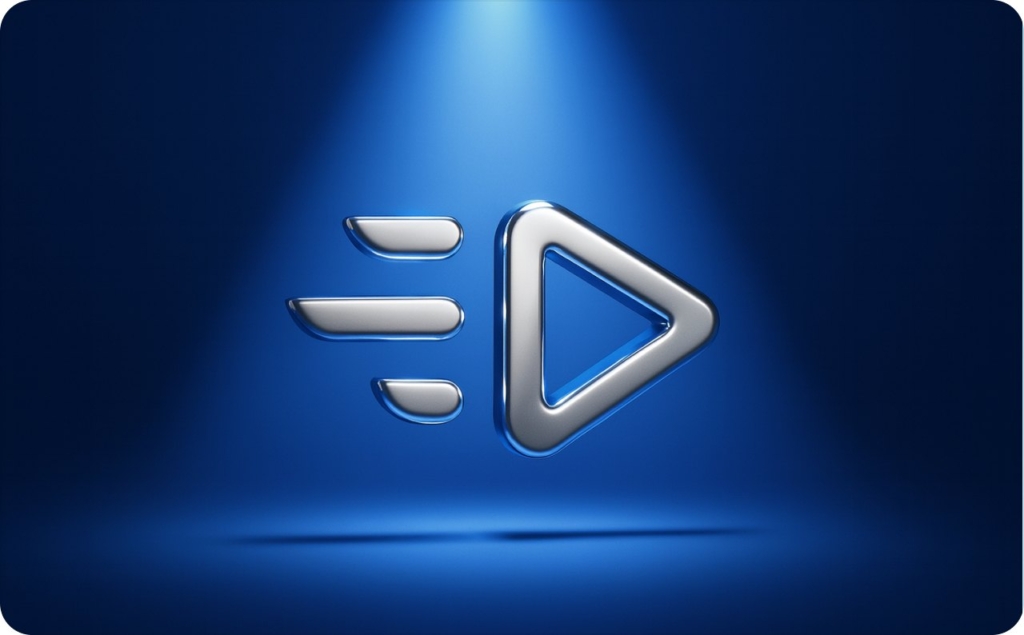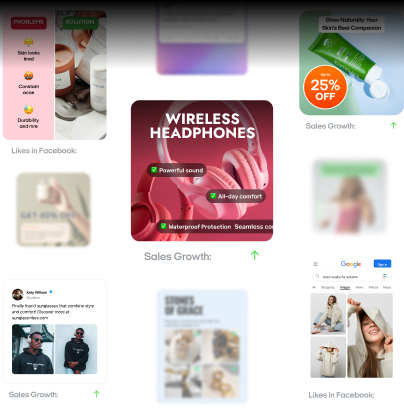Create viral video ads with AI in 15 minutes — how’s that possible?
You’ve heard the buzz around AI. Maybe you’re skeptical — wondering if it’s just another passing trend. But here’s the reality: AI is reshaping how video ads get made, slashing production time and costs in ways we only dreamed about a few years ago.
It used to take weeks and big budgets to produce videos that actually convert. Today, machine learning automates the grind, so you can create high-impact ads with just a browser and the right tools. No giant studio, no big creative team.
And it’s not hype. Statista says 91% of businesses already lean on video marketing, and global digital video ad spending is set to reach US$207.52 billion by 2025. As more brands flood the market, the fight for consumer attention is only getting fiercer. If you want to compete and win, you need strategies that keep up with this fast-paced evolution.
That’s exactly what this guide delivers. You’ll see how AI helps you launch smarter ads, scale faster, and free up your time for what matters most. We’ll cover top tools, lay out proven tactics, and give you a workflow that works — even if you don’t have a massive budget or an in-house production squad. Let’s show you how to get better results, outpace the competition, and seize new opportunities in video advertising without the stress.

Understanding the role of AI in video advertising
AI is changing how you create video ads by cutting costs and saving hours. If you’re tired of long editing cycles or lackluster performance, AI-driven platforms can fast-track your results.
Automating production with AI tools
Today’s AI video tools handle tasks that used to take days. They write scripts, edit footage, and generate voiceovers — all without a big team or production studio. Lumen5 turns blog posts into dynamic clips in minutes.
Zeely AI creates human-like avatars to share your message and offers real-time alerts so you know when performance dips. Each relies on machine learning to keep your brand on point while delivering polished ads in a fraction of the time.
Personalizing content in real time
Personalization makes your ads more than one-size-fits-all. You can show different content to new customers or loyal buyers — even if you don’t have a big CRM. Many AI tools pull data right from Meta or Google Ads, letting you tailor skincare tips for first-time shoppers and reviews for your top fans.
According to Forbes, personalized ads significantly improve CTR by speaking to each audience segment. Pair that with strong visuals and honest feedback, and you’ll see better conversion rates.
Data-driven analytics and optimization
Guesswork is gone when you use AI in advertising. It tracks CTR, conversion rate, and view-through rate in real time. If your view-through rate tanks mid-campaign, you might get an alert from Zeely AI suggesting a shorter clip. You’ll know exactly what to fix and can adjust headlines or visuals on the spot — true data-driven insights at work.
Where to go next
If you’re done with manual processes and guesswork, AI video ad tools let you automate, personalize, and optimize — all at once. AI transforms every ad into a growth engine by boosting performance while trimming time and costs.
Next, we’ll show you how to plug AI into your daily workflow. So you can launch better ads — and see real results — no matter your budget or team size.
How to create video ads: 5 main stages
You don’t need a big studio to make dynamic video ads that can really boost your ROI. You just need a clear workflow, the right tools, and a plan to optimize for each platform.
Define your objectives and identify your audience
Give your ad one main goal — like boosting sales, capturing leads, or building awareness. If you try to do everything, you’ll end up doing nothing. Figure out who you want to reach.
Use Meta Audience Manager, Google Analytics, or SparkToro to study their buying triggers and content preferences. If they shop at night, emphasize convenience. If they value sustainability, highlight eco-friendly benefits.
Research and ideation with AI tools
Don’t guess what works — research it. Check TikTok Ads, Instagram Reels, or YouTube Shorts in your niche to see which hooks or visuals keep showing up.
Then use AI tools to spark fresh angles based on competitor insights and trends. Filter ideas by how well they align with your goal, how clear the value is, and whether they fit a 15–30 second window.
Script writing and storyboarding
Keep your script short and purposeful. Aim for 50–75 words if you want a 15–30 second ad, and open strong with bold text or quick motion in the first 3 seconds.
Storyboard next. A simple layout in Zeely AI shows where text, images, or transitions go. That makes final editing smoother and keeps your messaging tight.
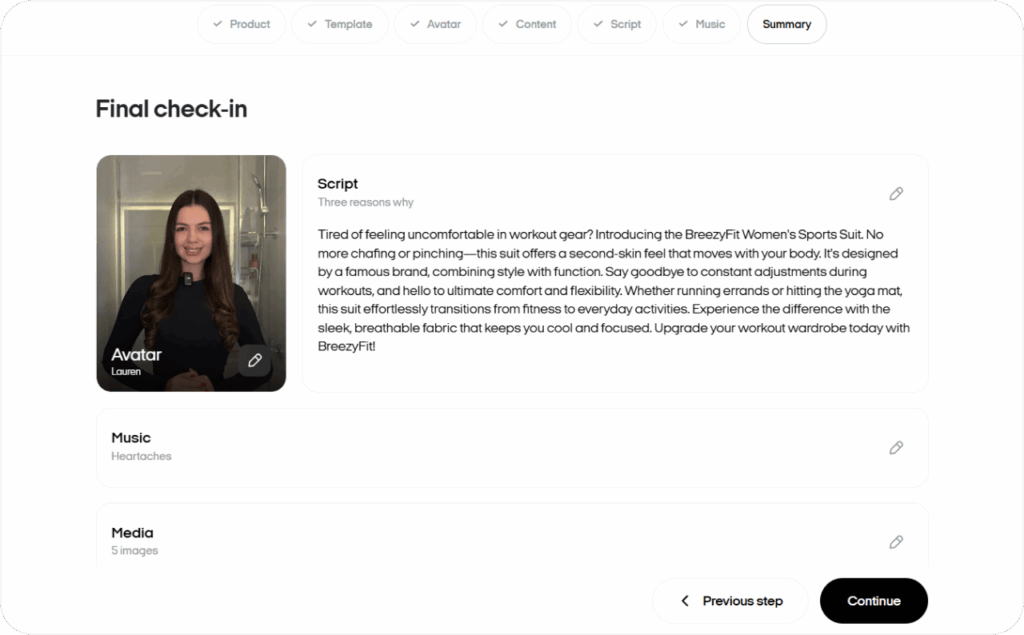
Production: Turning scripts into video content
Modern AI video editors make video creation less intimidating. Zeely AI is great for web-based edits and captions. It also handles multi-aspect ratios and script narration, and offers templates and brand kits.
Decide on a direct CTA like “Buy Now” if you want immediate action, or go softer with “Learn More” for mid-funnel users. Keep your pacing brisk, because nobody watches slow ads.
Mobile responsiveness and cross-platform optimization
TikTok loves short, sound-on clips with a vertical view. YouTube prefers widescreen format, with a strong hook in the first five seconds to fight the skip button.
Facebook and Instagram feeds autoplay silently, so consider on-screen text. Test small changes like opening lines, voiceovers, or CTA buttons using Zeely AI or Google Ads Experiments. Each improvement helps you drive more clicks, signups, or sales.
Users watch ads from different devices. Most of them use phones and tablets. We recommend creating mobile-first video ads to reach as many target audiences as possible and increase sales.
Wrap-up: Your next steps
Follow these five stages to create video ads that convert. Always keep your audience’s motivation in mind, and tailor each final cut to the channel you’re using.
Ready to start now? Try Zeely AI now, script your first ad, and see how viewers respond. Then refine, improve, and watch your results grow.
Create viral videos with Zeely AI
Tired of juggling complicated marketing tasks? Worried your ads aren’t catching enough eyes? Zeely AI is your new go-to for stress-free online marketing management. In minutes, you’ll create compelling ad materials and launch them right away — no guesswork needed.
Install the Zeely App on your phone and set up your user profile. Answer a few quick questions so the AI knows your style and preferences. Not a fan of phone apps? Use Zeely web on your laptop or PC instead.

Step 1: Add products
Paste your product URL and let Zeely AI pull in the images and details automatically. No website? No problem. Add your product photos and info by hand. Pick a product type, pick a CTA, and hit Create product.
Step 2: Create video ads
Choose the product you want to spotlight. Then select a video template designed to grab attention. Next, pick one of the 30+ hyper-realistic AI avatars that fit your brand. Don’t have a script? Zeely’s AI can write one using proven marketing tactics, or you can craft your own. Add background music to set the mood.
In up to 7 minutes, your ad is ready — sometimes even faster. While you wait, you can also create static visuals to run alongside your video ad. That’s it. You’re on your way to viral videos and next-level marketing efficiency with Zeely AI video ad creator. Enjoy more clicks, more sales, and more time to focus on what you do best.
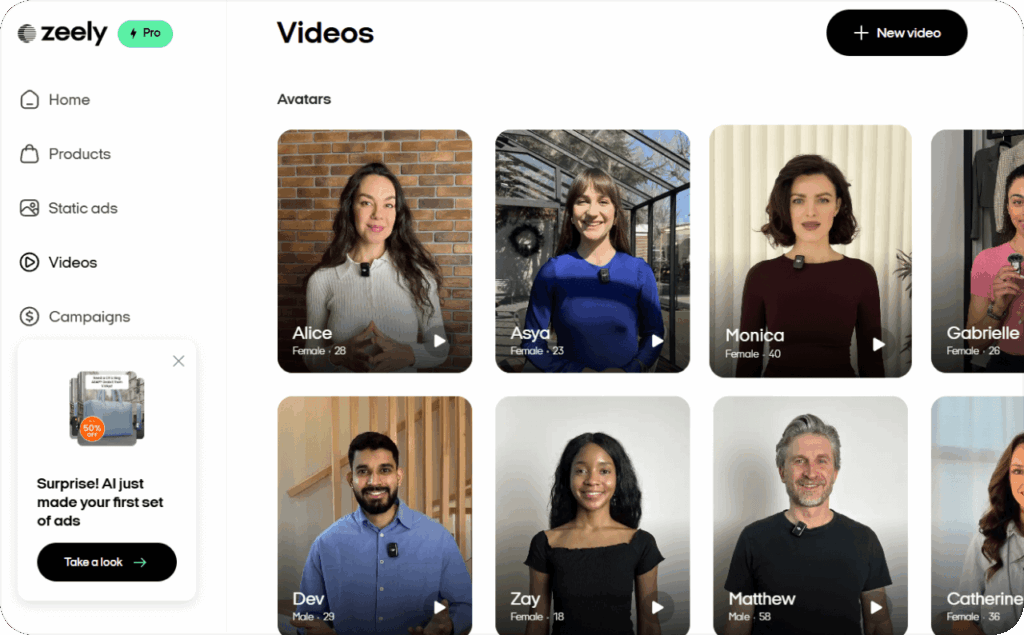
Best practices for engaging video ads
You want viewers to stop scrolling and pay attention. You need to hook them, connect emotionally, and guide them toward action — all in under 30 seconds.
Lead with a bold hook
Those first 2-3 seconds decide everything. Start with motion, bright text, or a bold question that ties to their pain point. On TikTok or YouTube, try a catchy audio track or a sharp voiceover. On Facebook or Instagram, use animated text or overlays to grab attention before they scroll.
Balance features with emotional benefits
Don’t just list product specs. Show why your offer matters, whether it’s making life simpler, healthier, or more fun. A quick micro-story can bring this to life. If you sell a sleep app, open with, “Tossing and turning again?” and show a user finally waking up refreshed.
Make your call-to-action unmissable
Your CTA should pop visually and appear early if you see drop-off. Say exactly what you want them to do — “Buy now,” “Sign up,” or “Try free.” Use contrasting colors or subtle animation so it can’t be missed. On TikTok, gesture prompts like “Swipe up” can guide interaction, while YouTube often uses end screens.
Test and tweak for better results
A video ad that works today might flop next week. Keep testing hooks, ad length, and CTA timing to see what boosts clicks and view-through rate. Machine learning tools like Meta Advantage+ or Google Performance Max can predict which creatives work best for each audience. A quick data check can show you where 30% of viewers drop off, so you can fix it fast.
Apply these video ad conversion tips
Use a strong hook, tap into emotions, and seal the deal with a clear CTA. Match each platform’s vibe — short, music-driven styles on TikTok, clickable end screens on YouTube, silent scroll on Instagram or Facebook.
If you sell fitness gear, open with “Tired of skipping workouts?” Show a 7-day transformation, then place a bright “Start Your Free Trial” button around five seconds. Tweak, measure, and refine, and your video ads will deliver real results.
Measuring and optimizing video ad performance
You can’t guess your way to ROI. You need the right video ad analytics and a plan to use them. Let’s walk through which metrics matter, how to run A/B tests, and where machine learning fits in.
Start with the right video ad metrics
You need three main KPIs to see if your ads hit the mark. CTR shows if your hook and CTA spark clicks, and anything under 1% might need a rework. View-through rate tells you how long viewers stick around — if it drops 30% by five seconds, your intro likely needs help.
Conversion rate measures real outcomes, like sales or signups. A higher percentage means better ROI measurement. Track these numbers so you’re not chasing vanity metrics but actually boosting your bottom line.
Track returns, not just clicks
It’s tempting to celebrate a great CTR, but is your ad making money? Focus on the results that matter to you — direct purchases, leads, or app installs. Meta Ads Manager, Google Ads, and TikTok Analytics all show which creatives and audiences bring higher returns.
Review data weekly and compare it to your past 7-day average. If you’re focusing on softer goals, watch for lead quality or lifetime value. The point is to see if you’re moving forward or spinning your wheels.
Use A/B testing to improve results
Once you have a baseline, test different hooks, CTA lines, or visuals. Change one thing at a time and run it for at least 7 days. If you see a 10–15% performance lift in your new version, keep it.
When your view-through rate crashes by five seconds, try a more dynamic opening. If your CTR stalls, switch “Learn More” to “Get 15% Off”. Small tweaks can create big wins in your video ad optimization.
Let machine learning do the heavy lifting
Platforms like Google Performance Max and Meta Advantage+ watch for patterns in watch time and clicks. They move the budget to the videos audiences like best. Even if you’re a small team, this machine learning approach saves you from endless guesswork. You decide on the creative angle. AI handles the heavy targeting.
Turn insights into action
Don’t just track your data — do something with it. Update your hooks, refine your CTAs, or rotate fresh visuals, then watch how metrics shift.
This cycle of measurement, testing, and improvement never ends. The more you tune your video ad analytics, the more you’ll optimize video ads for real returns — and that’s how you outpace the competition.
Conclusion and next steps
If you’re not improving your ads, they’re falling behind. Video ad strategy is never one-and-done — it’s an ongoing cycle of testing, analyzing, and refining. You’ve learned how to plan, create, and optimize video ads.
That includes creative testing, platform-specific optimization, and using data to drive results. Ask yourself where viewers drop off or which CTA underperforms. Start there for immediate gains.
In short, plan, test, analyze, improve — then repeat. That’s how you keep your ads relevant as your audience evolves. Ready to see real progress? Pick one focus — like rewriting your hook to address a pain point or changing “Learn More” to “Try It Free”.
Run a quick experiment and track metrics. If you’re not using paid tools, log everything in a spreadsheet or a free project board. Use Zeely AI to launch your first A/B test in under 15 minutes.
Watch your data, tweak your approach, then repeat until you see the lift you want. Every ad you publish is an opportunity. With consistent video ad performance reviews and continuous ad improvement, you’ll stay ahead — no matter how fast things change.
Also recommended

